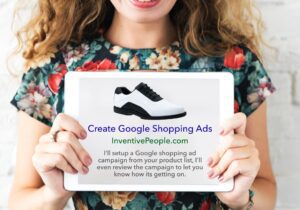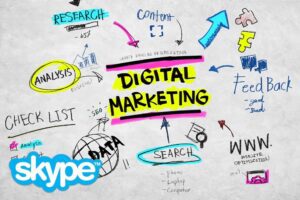IMC35: How to make your site accessible
How to improve your websites usability to appeal to the widest possible audience.
Notes
Related content
- Every design has the potential to include and exclude customers
- Dieter Ram’s 10 Commandments of Good Design
IMC34: WordPress Walkthrough 2021
From logging in to editing a page and posting a blog article Ben takes you step by step through setting up your WordPress website.
Notes
Related content
- #25 WooCommerce walkthrough – Inventive Marketing Club (GROUP) for Members
- #9 Blogging & Content Strategy – Inventive Marketing Club (GROUP) for Members
Why WordPress?
- Can get started for free on WordPress.com
- Completely flexible when self managed
- Plugins give it flexibility
- Best control over SEO
- Powers over 40% of the worlds websites
- Used by global brands
- Active community
IMC33: How to build the perfect ecommerce sales funnel

To watch the full video and get access to all previous videos and resources join my Marketing Club - Get free access for 30 days
Ben takes you through some key strategies to to build your perfect ecommerce sales funnel, from first contact to getting the sale. You’ll be able to apply the strategies in this video to almost any business even if you don’t sell online.
(more…)IMC32: Instagram Essentials
How to use Instagram in your business, grow your audience and track progress.
Notes
Why are small businesses using photo sharing apps in marketing?
- Increasingly in popularity
- Businesses of all sizes and sectors are using it
- A great way to bring a visual element to your social media activity
- Reaching new audiences easier and quicker
- Sell products or services through the platform
Instagram as Marketing tool
- Who should use Instagram?
How to post
- Can only post using app
- Photos
- Video
- Importance of Stories & Reels
- Hashtag research
Planning Content
- Use your social media strategy for inspiration
- Variety is essential
- Post regularly
- Find inspiration from other accounts
- Consider including video
Tracking Progress
- Set Objectives to monitor progress
- Audience growth – size & quality
- Interaction – likes, comments, reach
- Performance on paid ads
- Sales of products
- Traffic to your website
Commit to action
What one action will you achieve over the next 30 days?
IMC31: Facebook Essentials
In this marketing webinar Ben shares how to use Facebook in your business to grow your audience and win customers.
(more…)IMC30: The Future of Marketing
Ben chairs a discussion with Nicky Ayers (Ecl-ips CCTV), Catherine Every (Pippin Copywriting) and Jon Johnson (Mountain Perspective) looking at how future trends and challenges could impact on our strategies for lead generation.
Notes
What could the future of marketing look like?
You don’t own the platform
- Rely on social and ads for new customers
- The sales funnel is out of your control
- No direct access to audience
- What happens if their policies change?
People prefer to buy/work online
- People prefer digital experiences – Easier, quicker.
- Remote working reduces town centre visitors
- How do they find out about you?
Search is voice only
- In the car, jogging, cooking
- Voice assistants only surface the first few results
- How do you get found in a sea of a thousand results?
Tracking is dead
- Browser tracking cookies are being blocked
- Email is hiding your opens and clicks
- How can we target them on other platforms?
- Do we need to collect so much data?
What you can do about it
Build a strong brand
- Trusted and consistent
- Meet people where they are then invite them back to your place – your website
Tribe Marketing
- Work with partners or as a group
- Make use of their audience
- Refer often
Use Video
- Focus on personality (brand)
- Make it useful, share something of value, have fun
- Great audio/lighting
Use structured data
- Answer questions, add FAQ schema
- Be the ultimate answer on Google
- https://soundcloud.com/rather-inventive/interview-duane-forrester-yexts-vp-industry-insights
Be remarkable
Create email and social posts people really want to read, watch or be part of
IMC29: Getting clear on your business brand
Ben is joined by Benjamin Catley-Richardson (Brand Clear) to share how to be clear on your business brand. We walk through how to be easier noticed, easier to remember and easier to choose.
(more…)IMC28: Three big ideas to grow your social engagement
Ben shares three ideas that could help grow or even kick start your social media engagement. He has been developing the ideas over the years so you may already have heard a few of them but it’s always good to have a refresher.
Notes
Be Remarkable
How to create remarkable content that spreads further by working with others
- Choose a social network you like
- Where your audience hangs out
- Reach out to your audience
- Be remarkable
- Be consistent
- Connect on a personal level
Be the First to Follow
Understand how to attract people and create a movement
Start a Social Tribe
Local businesses promoting local businesses on the web and through social media
- Find your tribe
- Follow your tribe
- Spend 15 a day minutes engaging
- Recommend what you love
- Feedback to improve
- Don’t talk about yourself
IMC27: Social Media Roundtable
Ben is joined by Jack McCaughtrie (Core Tree) and Clare Harris to discuss the current state of social as well as tips and advice.
Notes
Social Media Round Table
- We look at social media accounts by activity
- Has social media use changed during 2020 lockdown? Has it brought us together?
- What kind of content works best?
- Does it pay to create personalised content and making the effort?
- Does social media work for customer service?
- How can I get more followers on social media?
Commit to action
What one action will you achieve over the next 30 days?
Need some Marketing help?
-
 Write the copy for your website£120.00 – £2,400.00
Write the copy for your website£120.00 – £2,400.00 -
 Write an engaging blog article£145.00 – £290.00
Write an engaging blog article£145.00 – £290.00 -
 Setup Google Shopping Ads£520.00 ex VAT
Setup Google Shopping Ads£520.00 ex VAT -
 Setup a standard Google Ad£390.00 ex VAT
Setup a standard Google Ad£390.00 ex VAT -
 Proofreading Service for Word Docs, PDFs or PowerPoint files£35.00 – £175.00
Proofreading Service for Word Docs, PDFs or PowerPoint files£35.00 – £175.00 -
 Half day Social Media workshop£520.00 ex VAT
Half day Social Media workshop£520.00 ex VAT -
 Half day Google Analytics workshop£520.00 ex VAT
Half day Google Analytics workshop£520.00 ex VAT -
 Digital marketing support call£130.00 ex VAT
Digital marketing support call£130.00 ex VAT
IMC26: Marketing Strategy: Expert

To watch the full video and get access to all previous videos and resources join my Marketing Club - Get free access for 30 days
My recommendations and advice for people regularly promoting their businesses who have completed the Foundation and Pro levels.
Notes
Marketing Fundamentals walkthrough (Expert)
Audience & Planning
- Review progress against business objectives
- Watch IMC #1 Planning your marketing strategy
- Ask customers why they made their decision to buy from you
- Watch IMC #14 How to make fab client testimonial videos
- Refine your customer persona
Stats & Analytics
- Identify two actions to increase website visits
- Review your stats on YouTube
- Watch IMC #3 YouTube Engagement
- Review stats on website landing pages and goals
- Review email clicks, which campaigns are working the best?
Web Design & Development
- Watch IMC #10 WordPress walkthrough
- Add the benefits of your product to your landing pages
- Offer a free trial or consultation
- Add customer case studies
- Add an interests drop down to enquiry form or newsletter sign up
- Begin to add CTAs to blog / news content
- Watch IMC #25 WooCommerce walkthrough
SEO & Content
- Register your business on 5 high quality online directories
- Perform deeper competitor research
- Search for the keyword on Google
- Review the first three organic result snippets (ignore the ads)
- Visit each of the first three results
- Compile your results
- Conduct a review of your landing pages
- Watch IMC #20: Blog Content Consolidation
- Arrange guest blogging to build credibility & backlinks
- Add additional topic related words to your landing page or blog content
- Write another two blog posts
Social Media
- Develop a sharing strategy for social
- Make your social posts remarkable
- Show awareness of ideal clients sector
- Introduce video into marketing activites
- Turn your what you learn into content
- Watch IMC #15 How we make our podcast
- Setup a pretty Facebook URL
- Setup YouTube channel linked to Google +
- Watch IMC 21: Mining LinkedIn to find prospects
- Create your Social Tribe
Email Marketing
- Collect visitors data with a compelling offer
- Design a follow up email with extra information
- Optimise your email layout for clicks
- Experiment with animated graphics or videos in your email
- Design a specific email newsletter targeted at your ideal client
- Test your emails to make sure they aren’t going into SPAM
Business
- Review your customers in terms of price, profitability, ease of conversion, previous business
- Raise your prices by 10%
- Focus on your best prospects first
- Use CRM to track the nuturing process
IMC25: WooCommerce walkthrough
Everything from setting up the plugin to products, discount vouchers and shipping and order processing.
Notes
Woocommerce is a full featured ecommerce system which allows you to sell a wide variety of physical products and digital products along with a wide range of extenstions for subscriptions and mentions amongst other things.
When you install Woocommerce for the first time
You need to access the Plugin tab on the dashboard at the back end of your wordpress website. Add new, then search for ‘Woocommerce’. It should be the top hit, press install now button and then activate to install.
Once it is installed you will get a little Wizard setup screen, going through some of the basic information.
Example site: https://ratherinventive.com/shop/
WooCommerce Key Tax Setup Tips
- Choose whether prices will be inclusive of VAT or not. Only shows it you enable taxes in General tab
- Chose whethere your customer base is business to business or business to consumer on which tax option you opt for.
- Calculate your tax based on your address. If your company is based within the UK, regardless of where the customer is located they will pay UK tax. There are lots of options available if you ship abroad and can rank your tax to correlate with different states and regions.
WooCommerce Key Shipping Setup Tips
- Shipping zones allow different options for each country or area you define
If you have any specific shipping issues, that I haven’t covered within the run through best to get in touch and run through these as shipping options are bespoke and taylored to each business differently.
Example site: https://campagnacollections.com/furniture/ where they have lots of different items and ship to different locations.
WordPress Payment
- By default Woocommerce comes with default payment details i.e Bank Transfer, Cheques, Cash on Delivery or Paypal.
- With each option you will follow the form to input your information and requirements.
- When setting up Paypal payments you will need to put in some details to activate this option. Ensure you capture the identity token so you can capture the payment and send the order details back to your website.
- We recommend Stripe highly for taking credits. You will need to add this as a plugin. It is free, there are lots of other free plugins for different payments method if you would like to chose something else.
Other payment providers: https://woocommerce.com/product-category/woocommerce-extensions/payment-gateways/
WordPress Privacy
- Options available that allow you to give access for guest orders or enforce customers to have an account to process the order.
- Information here to allow ppl to remove their data correctly through the woocommerce system.
WordPress Emails
- Get creative and customise your email communications that get shown to people
- Run through the settings to customise the look of your email
- Include company logo from your media library
- By default, the email settings are quite basic. There are other ways of customising that in code or find plugins to allow you to customise emails.
Products
- Highly recommend categorising your products so you are able to show targeted products on particular web pages of your site.
- You can also add thumbails for each category
- By default it will show related products in the same category but it possible to create upsell / cross sell items
Coupons
- Setup a Coupon under the Woocommerce menu tab
- Click Add Coupon which will allow you incentivise your customers by adding a discount off the final basket value.
- You have the option of percentage discount or fixed price discounts
- You are able to tailor the coupon to specific emails or products, limit the amount of time it can be used, set an expiry date etc
Processing orders
- Admin and customers get order emails (processed)
- Back payments will be put on hold until it is processed
- Once shipped or finished, orders will be marked as completed. Customer will get a final email to confirm the order
- In this page you can also refund orders from this screen
IMC24: Marketing Strategy: Pro

To watch the full video and get access to all previous videos and resources join my Marketing Club - Get free access for 30 days
My advice for business getting serious about their marketing. These tasks follow a similar format to my Foundation level but will be suited to business already doing a bit of marketing.
Notes
Marketing Fundamentals walkthrough (Pro)
You’ve graduated to the pro level well done. These tasks follow a similar format but will be suited to business already doing a bit of marketing or those who’ve completed my Foundation level.
Audience & Planning Section Highlights
- Review progress against business objectives
- Watch IMC #11 on understanding your customer
- Compare your customer needs to your product fit
- Write down your customer needs for each of the three buying stages:
- 1. Awareness (social activity, adverts etc)
- 2. Consideration (help articles, FAQs)
- 3. Decision (product details, checkout)
- Build a customer persona: Download Persona Template
- Write a customer pain list of questions that you can help with
- Invite clients to take an online survey to get feedback
Helpful Links:
#11 Understanding your customer – Inventive Marketing Club (GROUP) for Members
3 simple steps to find your ideal clientAsk an expert to help you with this
How to Use Customer Satisfaction Surveys the Right Way
Create simple surveys in Google Forms
Stats & Analytics Section Highlights
- Watch IMC #7 on how best to use Google Analytics
- Check out your stats in GA
- Decide which GA stats you need to measure to reach your objectives
- Setup GA Goals to track activity on your website
- Identify one action to increase website visits
Helpful Links
#7 Google Analytics – Inventive Marketing Club (GROUP) for Members
About Goals in Google Analytics
Website Design & Development Section Highlights
- Grade your website and marketing (again)
- Watch IMC #8 to learn why image optimisation is important
- Reduce image size
- Remove unused plugins or add-ons
- Ensure your website navigation is clear and simple
- Audit your page content to ensure information is current
- Make sure your website has a Call To Action
Top Tip: Don’t delete plugins straight away, leave them deactivated for a couple of weeks just to make sure you don’t need them. If you have had the site developed by a web developer ask them to double it check to ensure that ones you are not using aren’t slowing down your site.
Helpful Links
IMC #8 Image EditingInformation on Optimising Imagescompressnow.comtinypng.comImageOptimSafe SVG plugin
Speed up your WordPress website
SEO & Content Section Highlights
- Watch IMC #6 on SEO tips and strategy
- Research competitor sites on Google
- Write a blog article that answers a question from your customer pain list
- Check that your site’s page titles clearly relate to the page content
- Create unique descriptions for each page
- Watch IMC #16 on Improve landing page SEO
- Create a landing page for each keyword
- Listen to Greg talk about SEO and affiliate marketing
- Write two blog posts
- Get listed on Yell.com
Helpful Links
IMC #6 SEO Strategy
Get an expert to write an article for you
IMC #16 Improve landing page SEO
On-Page SEO, a beginners guide
How to write for business – cutting out the waffle
Social Media Section Highlights
- Watch IMC #4 on reviewing your LinkedIn profile
- Add business website links to your LinkedIn profile
- Endorse 3 people on LinkedIn
- Send LinkedIn connection invites to people you met recently
- Watch IMC #12 for tips and advice on Google My Business
- Optimise your Google My Business profile
- Ask customers to write a Google review
- Connect with target clients on LinkedIn
- Set up a business Twitter account
- Participate in a local networking hour on Twitter
- Set up a business Facebook Page
Helpful Links
IMC #4 Get more out of LinkedIn
LinkedIn Skill Endorsements – Overview
Watch IMC #12 Google My Business walkthrough
IMC #5 How to get Five Star Reviews
A Complete Guide To Twitter Networking Hours
Email Section Highlights
- Watch IMC #2 Using email marketing effectively
- Setup an email newsletter service
- Collect email addresses from visitors to your site
- Review your email strategy
Helpful Links
IMC #2 Using email marketing effectively
8 Small Business Email Marketing Tips for 2020
Add a Signup Form to Your Website5 simple steps to your email marketing MOT
Business Highlight Section
- Create a spreadsheet to track your leads
- Listen to Rocky Romanella business leadership development
- Watch IMC #13 Productivity at work
- Review your sales process from initial lead enquiry to final invoice
Helpful Links
Example Google Lead Sheet
Watch IMC #13 Productivity at work
IMC23: Marketing Strategy: Foundation
My recommendations and advice for a startup or business new to marketing.
Notes
Marketing Fundamentals walkthrough (Foundation)
https://ratherinventive.com/blog/marketing-strategy-foundation/
My recommendations and advice that I have gained from working with over 500 companies in the last 10years. This is the Foundation level out of the series which is targeted at startups and businesses that are new to marketing.
Planning Section Highlights
- Write down three things you’d like your business to achieve over the next 12 months
- Take each objective and note down how you’ll achieve them
- Try writing your company strap line in 20 words
- Describe your ideal customer in 5 words
- Listen to how Gina Geoghegan started her drinks business Wild Fizz Kombucha
https://soundcloud.com/rather-inventive/wild-fizz-kombucha-interview
Top Tip: Spend more time on your planning than anything else as every hour you spend planning will save you so much time in the long run.
Analytics Section Highlights
Start setting things up as when you advance to the other marketing levels you will have something useful to work with.
- Set up a Google Analytics profile for your website
- Read beginners guide to Google analytics
- Set up a monthly Google Analytics email report
Website Section Highlights
I am assuming you have sort of website, if you don’t skip this section but for now we want to see where you are:
- Grade your website performance
- Make a backup of your website
- Check your website has no page errors
- Update your website content manager and any plugins to the latest version
- Add a cookie policy to your website to be GDPR compliant
Helpful Links:
https://ratherinventive.com/blog/imc-podcast-10-what-your-website-needs-to-be-legal/
https://ratherinventive.com/blog/boiling-essentials-gdpr-first-step-navigating-new-regulation/
SEO Section Highlights
- Check you have a Google friendly site
- Localise your primary keyword
- Research your primary keyword
- Find out the Google position for your primary keyword
- Check home page title and description are eye catching and interesting
Helpful Links:
https://ratherinventive.com/blog/imc-podcast-1-creating-an-seo-strategy/
https://ratherinventive.com/blog/imc-podcast-2-building-on-your-seo-strategy/
Social Section Highlights
A couple of simple things to cover but we go into more depth on the Pro Level:
- Set up a personal LinkedIn profile
- Set up a Google My Business page
- Get Local with Facebook and Google My Business
Helpful Links:
https://support.google.com/business/answer/2911778?hl=en-GB
https://public.3.basecamp.com/p/tTQrpkkRZjz1K98PiAvjtiEj
Business Section Highlights
This is everything else, all the admin but all useful stuff
- Understand basic marketing and accounting terms
- Set up a spreadsheet to log your business numbers
IMC22: Create an Google Ad walkthrough
This webinar is a screen share walkthrough of how to create text ad on Google. I share some of the tips I’ve learned along the way and my process for planning and creating ads on Google.
Notes
Where possible try to do inbound marketing put information out there for people to find. However, advertising and outbound marketing can help kick things off to start with. It can be good to combine the two.
Inbound – You put out information i.e. a how to guide, a video, give and share information. Your customer will find it online and share it for you.
Outbound – Pushing information at your customer; disrupting what they are doing i.e. a phone call, advert.
Planning
Advertising comes down to planning:
- Goal – What do you want to happen?
- Audience – Who is it for? What are their needs?
- Benefits – Why does your product matter?
- Budget – Guess at first, quickly learn acquisition costs (£ ads / # orders)
Review and monitor your adverts regularly.
We’ll be using CCTV Logbook from Ecl-ips as an example. This web app helps people audit their CCTV system hardware.
Campaign 1
- Goal: Signup for a trial walkthrough webinar
- Audience: Security Managers who need to know when assets where maintained as they are responsible for site security and cannot have any cameras or recording
equipment out of order. Saving time for staff or external engineers - Benefits: Detailed CCTV camera asset log, Maintains full audit history, Easy to use, Save time on engineering audits
- Budget: £600/mo (£20/day)
Campaign 2
- Goal: Watch video ‘How to manage GDPR and privacy for CCTV’
- Audience: Business Owners who need to comply with legal obligations of data protection enforced by ICO. Don’t want to risk fine.
- Benefits: GCPR compliant and secure. Reduce risk of fine from ICO
- Budget: £300/mo (£10/day)
Recommend video IMC11 Understanding your customer
Research
Quick research
- Search keyword in Google, note the main phrases used
- Scroll to bottom and look at related searches
- Build phrase lists for each campaign
Detailed research
- Tools / Keyword Planner
- Discover new keywords
- Add keywords from campaign phrase list
- Find more keywords, look for ones with higher searches and low competition
- If low search volume then might need broader range of keywords
- Check out the competition, what other ads/organic results are there? What are they offering?
Create keyword list
cctv logbook, cctv audit, cctv audit template, cctv audit report, cctv camera inspection checklist, cctv asset manager, cctv maintenance report, cctv audit system, audit software, cctv audit software
Split into two ad campaigns
CCTV Log Book
cctv logbook, cctv log book
CCTV Audit Template (or CCTV Audit Checklist log)cctv audit, cctv audit template, cctv audit report, cctv camera inspection checklist, cctv asset manager, cctv maintenance report, cctv audit system, audit software, cctv audit software
Forecast the cost
- Tools / Keyword Planner
- Get search volume and forecasts
- Experiment with different initial click costs
- Use to explore price to per per click
Creating a new campaign
- New campaign / Leads / Search / Website visits
- Website: https://cctvlogbook.com/
- Add main keyword to campaign name: cctv logbook
- Don’t include display partners. Dilutes traffic
- Expand more settings
- Add end date. To prevent leaving active. 30 days to start.
- Add schedule to run between 07:00-22:00. Separate for week day and week ends to make easier to review and disable
- Target to location. UK in this case as low searches but may wish to target locally
- Add a budget: £20
- And focus on conversions
- Add site links, extra links to specific pages
- Add call extension if relevant
Setup ad group
- Name as primary keyword
- Add keywords. BMM, Phrase and Exact. Allows easier review later
+cctv +logbook+cctv +log +book”cctv logbook””cctv log book”[cctv logbook][cctv log book]
Create ads
- Start with Google defaults and amend
- Create multiple adds with different wording. You can review and pause.
Google Ads Walkthrough Tips
- Never use broad keywords. This will waste your budget
- Analyse best keywords to use in tool like Google Keyword planner
- Search main keywords in Google to make sure expected results are returned and the keywords mean the same to you and Google
- Look at competitor adverts. Find out who is number one
- Limit number of ad group keywords to five and keep to same topic
- Use exact match [my keyword], phrase match “my keyword” and Broad Match Modified (BMM) +my
- +keyword to capture broadest range of traffic and help review process
- Use bid stacking e.g. Pay more for exact match (most expensive), phrase match (next), then BMM (next)
- Check devices: and change bid adj if want to exclude device types such as mobile
- Setup ad schedule 7am-10pm for general viewing and removing time waster clicks
- Ideally link to dedicated landing pages on website with text that mirrors the ad
Swipe-Worthy – Marketing, Ad and Copywriting examples
IMC21: Mining LinkedIn to find prospects
Learn more about mining LinkedIn to find prospects and then how best to engage with them.To help me explore this topic I’ll be joined by social media and blog writer Jack McCaughtrie from (Core Tree).
Notes
Guest Jack McCaughtrie from Core Tree
Why mine Linkedin for prospects
- Remote networking
- Local, national or global reach
- Connect with difficult to reach individuals
- Build awareness of your company and how to help people
There is less noise in the channel, because it is a business to business platform it has a more professional mentality to it and people are more diligent in their approach
Jack McCaughtrie
Case Study – Witley Jones
Bespoke school furniture manufacturer, based in Worcestershire.
- They wanted to build their awareness and engagement in education
- Trying to get an in, in a busy market
- Approach of not hard selling but one of trying to support and align partnerships
Understand, Engage and Convert
Building an Audience
- Quality not quantity
- Reconnect with contacts, clients and colleagues
- Use market intelligence to identify new companies and people
- Connect with new people you have (or going to) meet
- Digitising your network
…you have 100% control who is in your audience and have control in targeting the right people. It is important you connect to the right kind of audience, a target client or prospect who have some value to you or you to them.
Jack McCaughtrie
Search
- Use Company Pages to find best contacts
- Search for Job Titles,
- Location and industry
- Set up ‘Search Alert’ for weekly email
Who to connect with
- Connect with people who are directly relevant to you
- Associated with markets you work with
- People who would be interested in content you can share
- People you can help with
- Don’t simply collect connections
- Connect with people that interact with your posts
Start a conversation
- Personalise your connection invitation
- Soft intro message once connected. Not sales focused
- Ask questions to encourage a response
- Follow 2/3 days after invite accepted
- Be patient
Breaking the ice
- Be inquisitive about their business or sector
- Make an opportunity to send more information – relevant blog or video
- Refer to a post they have shared recently or something you have seen on their website
- Ask a favour (Benjamin Franklin effect)
Nurture & Follow-up
- Sow the seeds that will grow over time
- Be patient. Building relationships take times
- Have regular content to share within your network
- Ask who the best person to contact
- Ask if you can share more information
- Don’t be afraid to follow up once, twice, three times
Review your profile
- Must be up to date and accurate
- First impression counts
- Make it relevant to your audience
- Answer the questions your new connections will have
- Add link to website and videos
- Consider the posts you share and engage with.
Marketing Strategy: Expert Level
Wow, you’re now on the Expert level. As with the previous tasks they follow a similar format but will be suited to business regularly promoting their business or those who’ve completed my Foundation and Pro levels.
Jump to a specific category:
- Audience & Planning
- Stats & Analytics
- Website Design & Development
- SEO & Content
- Social Media
- Email Marketing
- Business
IMC20: Blog Content Consolidation
Ben is joined by guest Copywriter, Catherine Every (Hello Pippin) to discuss how to review your blog to find the best-performing articles and which ones need cutting away.
Notes
Guest Copywriter, Catherine Every (Hello Pippin)
What is a blog review and why do we do one?
- Remove thin content / consolidate articles
- Aim: to focuson content quality, improve search visibility, build traffic
Casestudy
Communion Architects www. communionarchitects.com
They have built up a lot of posts over 8 years some with good traffic but could be improved.
Collecting the data
- Collect data over a full two year period
- Export article pages from WordPress
- Marry up article pages, GA, GSC data into Google sheet Compare which pages most visited from search
- Find low performing pages and review
Blog Review
- Start with the low performers (<10 visits)
- Then tackle pages with >50 unique visits
- Make notes on pages actions to take
Review Process
- September 2019 and January 2020
- Review all posts, make notes
- Start with the easy stuff: delete or fix broken links, images
- Combine posts: Read, outline new content, collate, rewrite
- Review in a day or with Alex (client)
- Key challenges
Review Checklist
- Can content be deleted and redirected?
- Can content be merged with other articles?
- Should the article be split up and extended?
- Can URL, title be improved? Keywords added
- Can content be improved
- Is it in the correct category?
- Any missing images or broken links?
- Can any relevant images or videos be added?
- Does it have a link to a landing page?
- Are there any content gaps?
Tidying Up
- Site audit to make sure everything works
- All deleted posts are redirected to new ones
- All internal links point to new articles
- Note content ideas for future articles
- Be careful not to change URLs for key pages
IMC19: Architectural Photography
I’m joined by Jack Nelson (Photographer) to discuss why great photography is crucial to show your property in the best light.
Notes
The importance of great photography
- Why is it worth the time and money?
- Examples: Exterior Croome Court, Interior Croome Court & Heath Town
Get the lighting right
Examples: Kensington Palace & 3D Render image comparison
Staging
- Interior or exterior
- Make sure everything is neat and tidy
- Image examples: Airbnb Slide 17 & Airbnb Slide 18
- Light and bright
- Dark and Dull
- Trace of life
Video walkthrough
- Drone or Handheld
- Understand the layout and flow better than photos
- 3D Experiences
3D Experiences
Matter Port
- User lead, Immersive, Fun
- System to capture and display 3D Photography Visitors explore in their own time
- Ideal for estate agents, also great for holiday lets and shops
- Make your own Matterport 3D on iPhone
- Matterport demo on https://bengoughproperty.com
Augmented Reality (AR)
- Move freely within 3D space View products in situ
- Communion AR example and commentary video
- www.apple.com/augmented-reality/
IMC18: How to design and build a website
Ben shares his website design process from planning to going live as well as reviewing some of the most popular website platforms to chose from.
(more…)IMC17: Google Search Console (GSC) walkthrough
In this episode Ben talks you through how to use GSC (Google Search Console) to find your website Google rank and page errors.
Notes
What is Google Search Console (GSC)
Tool that shows data from Google Search Understand how people find you online What keywords get the most clicks Identify problems on your site
Setup and verify
- Domain or specific URL
- Example mydomain.com for Domain or https://mydomain.com for URL
- Prefer verifying with GA
Overview
At a glance look to make sure there are no issues
Performance
- Compare traffic you are getting with clicks
- Impressions are times snippet show in search results
- Clicks are when people clicked through to website
- Queries are the search terms people use
Identify traffic issues
- Filter on blogs
- View traffic to pages. Why lots of impressions but not many clicks
- Click URL to filter on specific URL and view queries
- View average position, are things headed in right direction
- View page snippet and page content, do they make sense
SERPS
- What search engine ranking position you are for certain keywords (Add new query)
- Add new query for ‘marketing club’
- Just started optimising. Starting to get impressions but lacking clicks
- View page snippet and page content, do they make sense
URL inspection
- Make sure a page is indexed and if not expedite indexing
- Adding or refreshing a sitemap can also force Google to index your site again sooner that it would otherwise
- Check snippets work
Coverage
- Start with errors first
- Next any pages that are blocked from index
- Email domain believed to be from client’s posting email link on website
- If issues fixed you can re-verify
Excluded pages
* Why are they indexed? Are they linked on your site?
* How to find links that appear on your website site:ratherinventive.com “email.ratherinventive.com”
* This year we changed over the site. Found lots of old URLs still in Google index and have setup redirects to new pages
* Yoast also had an issue where it made all image into pages
Sitemaps
- Add sitemaps to make sure google indexes all your pages
- Also helps highlight if there are pages in the sitemap aren’t indexed
- On WordPress Yoast SEO plugin makes sitemap Yoast > General > Features > XML Sitemaps (click question mark), then see the sitemap
Removals
- Useful if you must have a page removed from the index
- Temporary measure. Make sure the actual content has been removed, marked as 404 or no-indexed
Enhancements
- Mobile had an issues, fixed it and asked to ‘Validate Fix’
- Make sure no issues with bad or missing structured data
- Recommend listening to interview with Duene Forester on structure data and why you should use it https://ratherinventive.com/blog/duane-forrester-yexts-vp-industry-insights/
Manual Actions
Make sure there are no penalties against your site
Links & Settings
- Interesting to see what domains are linking to you
- Add other users. Only give full permission if they really need it
Connect Google Analytics (GA) to GSC
Allows you to view the search data and landing pages in GA
IMC16: Improve landing page SEO
Ben shares how to improve landing page SEO by optimising a specific page of your website to rank higher on Google.
Notes
Improve landing page SEO
Optimising a specific page of your website to rank higher on Google
What is On page SEO?
Work on your site to improve SERP (Search Engine Ranking Position)
All in your control (website platform dependant) Watch session #6 for general SEO Strategy.
Selmach Case Study
Sell high value metal working machinery a Competitor was starting to win business and their Laser landing page was not ranking in Google results.
The Method
Competitor Analysis | Make Changes to Page | Measure Result
Step 1: Competitor analysis
Compare the Competition’s SEO to our page Keyword Correlation Report and interpret the findings into action.
Process
- Group call – Client, SEO, Web dev
- Review the report – Needed interpreting
- Decide on easy wins
- Basecamp to assign actions
Observations
- Category Landing Page (LP) not in 100 SERPs
- Title tag not using optimised keyword
- Poor/few internal links
- No external links to landing page
- Increase word count to over 1400 per page
- Add keyword or variations into content more
- Use variety of content: Lists, images, tables
- Use schema markup
- Page not in index. Yoast issue
Step 2: Make Changes
- Made observation changes to the landing page.
- Add links from other pages.
- Create the ultimate guide
What we did
- Add keyword to heading: CNC Fibre Laser
- Optimise meta description. Not too long and include keywords
- Added product info, testimonials, FAQs, images, comparisons
- Add keyword variations into content
- Added FAQ schema markup
- Add links from related news articles back to LP
- Another review to check progress
Step 3: Measure & Tweak
- Measure SERP (Search Engine Ranking Position) Content update took one month
- After two months jumped to #3
- Then to #1 one month later
What is a Keyword correlation report?
Comparison of your page against competitor pages based on keywords you want to rank for.
On page SEO tips
- Title, Meta Description and Heading must include keyword
- Great the ultimate guide. 10x better than competitors
- Use variety of content such as headings, lists, images, tables
- Include keyword variations in the content
- Make sure all related blog, product and supporting pages link to LP
- Build external links from other websites to the LP
- Use FAQ and other schema markup
- Check in GSC that page is indexed!!!
Helpful Links
- Why Use Schema, Duane Forrester shares some helpful insights on a previous podcast interview.
- Mark up your FAQs with structured data
- Comprehensive website SEO report to improve your search position and ranking against competitors.
- Book your Super-Correlation Keyword SEO Report for focused optimisation on your landing pages
IMC15: How we make our podcast
Ben shares everything we do to create our Rather Inventive podcast, including lessons learnt, stats and helpful tools.
Notes
What is a podcast?
- On-demand radio show
- Daily, weekly, monthly
- In a series
- Generally audio only
- Over 550,000 on Apple Podcasts in more than 100 languages (June 2018)
- 49% people listen at home
- Podcast listeners are loyal and affluent
- 81% of people take action as a result of listening to a podcast
Sources
https://www.podcastinsights.com/podcast-statistics/
https://rainnews.com/spotify-shares-podcast-stats-and-advertising-examples/
Why did we start a podcast?
- Used to record radio shows on tape recorder
- Chatted with Al regularly, good to share
- Great opportunity to meet people
- Wanted to learn
If you’ve not subscribed to the podcast please do at https://ratherinventive.com/podcast/
- April 1st 2014 First show with Nick Van der Walle
- November 2018 – First video podcast
- December 2018 – Moved entire podcast to video
- October 2019 – Interview with Nick again!
- March 2020 – Latest podcast with a magician
Over 90 recordings!
Format
‘Two guys chatting’
Interview show
Reporter / NPR
One voice
Our process
Prep
Structure has evolved
Show notes
List out questions
Practice your start and ending
Script for Podcast running order (template)
Guests
It started with an interview
Interview people that inspire you or youraudiencee
Scheduling – Doodle, Calendly
Script for Inviting a guest onto your podcast/vlog (template)
Recording
Audacity, Quicktime
Zoom, Demio
iPhone (front and back cameras)
External microphone – reducing echo (I use Shure MV5)
Editing
We edit for audio consistency
Audio only – Fission, Quicktime, Audacity
Video – iMovie, Final Cut, Adobe Premier, Shotcut
Music – Intro, background music, Envato Elements (£13/mo, Free account 12 free files/month)
Publishing
Titles – Informative / funny
Graphics – Find the smile
YouTube (free), SoundCloud (£125/yr) / Libsyn (£52/yr)
Sharing
Share on Twitter and LinkedIn. I prefer LinkedIn
Better to share direct link to video/media or teaser clip
Tag in any guests. Share link by email
Sponsorship
How to ask. Pitch an idea Insert or live read Industry standard CPM £10-20
Charge what you think it is worth
Script for Asking for sponsorship (template)
Starting something newTakes a lot of effort and planning
Want to focus on RI, not just guests
Build up IMC
Marketing currently too diverse
Re-use current material
Need some Video help?
-
 Event video filming and production£380.00 – £885.00
Event video filming and production£380.00 – £885.00 -
 Edit your supplied video footage£70.00 – £1,300.00
Edit your supplied video footage£70.00 – £1,300.00 -
 Create video from a slideshow of images£50.00 – £190.00
Create video from a slideshow of images£50.00 – £190.00 -
 Client case study video filming and production£380.00 – £885.00
Client case study video filming and production£380.00 – £885.00
IMC14: How to make fab client testimonial videos
Learn why you should start asking for video testimonials. I share my tips on filming & editing including my recommendations on which software to use.
Notes
Why you should start asking for video testimonials
- Helping people make a decision
- Adding value
- Educating potential customer
Stats
- 92% of customers read online reviews before buying
- 70% of people trust reviews from strangers
- Customer reviews create 74% increase in product conversion.
- Videos trigger emotions. We mirror people
- Video has a higher retention rate compared to text Videos are easier to share
How to ask for a video testimonial
‘Can you do me a favour’
Opportunity for customers to get involved
View full list of email templates
Interview formats
Formal Interview
- Traditional / professional
- Interviewer behind camera or facing each other
- Considered response
- Take longer to organise and film
Quick ‘Vox Pop’
- Casual, more authentic
- Capture opinion and emotion
- Quick to film and request
- Risky for live broadcasts, if unplanned
Video Conference
- Easier to schedule, less travel
- People feel more comfortable in own environment
- Difficult to control audio/visual quality – Internet speed!
- Limited camera angles
Selfie
- Authentic / intimate
- Easy to request and schedule
- Mostly concise. Ask one question
- Rely on technical ability of customer
- Easier for people to say no. Incentivise?
Questions to ask
- Impart trust and proof of your service
- Get a testimonial
- Share something secret or a tip
Questions to ask
‘What’s your name and who do you work for’
‘What do you do and how do you/your company help people’
‘What’s one thing you do that people remark on or enjoy’
‘What one area have [insert company] helped you in your business’
‘If you were to recommend [insert company] to a friend or colleague, what would you say?’
Sample questions you can use for your own interviews
Tips for filming, editing and publishing great video
Filming. Audio first, then lighting
- Use external mic, close to mouth. Get rid of external noises. Soft room
- Outside or face a window. Turn on all lights. Not backlit
- Turn camera on early, avoid starting. Practice run
- Sit dow to relax and prevent moving in the shot. Table in front for protection Be positive and be relaxed. People will echo this
- Allow time, don’t rush. Remove distractions and pressure
Live or recorded?
- Shared immediately
- Cannot correct or fix
- Make sure to warm people up Record ‘as live’
Cut aways
- Filming extra footage ‘B roll’
- Buildings, products, people milling (soft focus)
- Get more than you think you need
- Use another camera for alternate angles
Editing. Story is key
- Jump cuts or hidden edits
- Make notes of good takes.
- Use mini whiteboard
- Start with the best interview clips
- Edit out dupes, cough, ems etc Remove waffle
Hiding edits
- Two camera angles
- Behind interviewee’s head
- Noddy shots of interviewer
- Cut away shots that relate to conversation
Publishing
- YouTube / Vimeo
- Create your own Thumbnail. Optimise for smiles
- Embed on blog post or client page
- Add mini text transcript to video or add to blog
- Title for SEO so people can find e.g. ‘Avigilon camera review’
The kit Ben uses
- iPhone 7. iPhone 11 has better cameras
- Shure MV5 mic. Tie clips would be better for formal interviews
- Clips on iPhone for quick social posts
- iMovie or Final cut for formal edits (macOS / iPhone)
- Manfrotto tripod.
- Joby iPhone mount
- Mini whiteboard (new idea)
Need some Video help?
-
 Event video filming and production£380.00 – £885.00
Event video filming and production£380.00 – £885.00 -
 Edit your supplied video footage£70.00 – £1,300.00
Edit your supplied video footage£70.00 – £1,300.00 -
 Create video from a slideshow of images£50.00 – £190.00
Create video from a slideshow of images£50.00 – £190.00 -
 Client case study video filming and production£380.00 – £885.00
Client case study video filming and production£380.00 – £885.00
IMC13: Productivity at work
Ben shares his thoughts on how to make better use of your time so that you feel more in control of your workload.
Notes
Productivity books / Concepts / Workflows etc
So much info out there but much of it is fluff
Getting Things Done (GTD)
- Ben’s first productivity book
- Capture actions in a trusted system
- Do the small things first
Capture everything
- Note down ideas, actions and thoughts in a trusted place.
- Use Apple Notes, small memo book
- Helps stop your mind racing
Process your inbox(s)
- Clear to zero – Paper inbox, capture system, email Do, Delegate, Delete – Don’t skip anything
- Process your inbox each day
- Set aside time in the calendar
Is it actionable?
Yes: Do, Delegate or Defer
No: Delete, Incubate, Reference
Weekly review
- Collect your thoughts
- Note down in trusted capture system
GTD Podcast
Really interesting podcast, even if you don’t do GTD https://gettingthingsdone.com/category/podcast-2/
Working with email
- Archive emails, don’t file them
- Search when you need them
- Use a clear subject line, so you can find it later
- Only include people that need to see it Filter email (if you can)
Default diary
- Block out regular time
- Share with your team / partner
Don’t let time be stolen from you
- Keep meetings short / request short meetings
- Turn off notifications
- Plan time for social media etc
Don’t write it twice
- Think like a lazy programmer
- Save time
- Reduce mistakes
No excuses
- Get on with it
- Take responsibility
- Just start
Be above the line. Accountability not Blame
Idea from ActionCoach
Helps to prevent procrastination
Exercise
30-60 minutes a day. Walking is fine
Get access to light
Get 7-8 hours sleep (or as much as you need)
Free audio books
Free copies of my fav
Audible books Ping me if you want me to gift you a copy
IMC12: Google My Business walkthrough
In this Google My Business walkthrough Ben covers everything from claiming your listing, setting the correct categories to optimising for SEO
Notes
Why use Google My Business (GMB)
- Only way to get into the local pack
- Small factor (<9%) in regular SEO
- Get a knowledge panel Collect reviews
- Control of your map listing – Anyone with a Google account could: suggest an edit, post photos, ask awkward questions
Screen-share of Google My businessCreating/claiming a listing
- Check in maps to see if listing already exists https://www.google.com/maps
- If not then start creating https://business.google.com/create
Getting your profile info order https://business.google.com/dashboard/l/11925252192446860058
- Title – Your company name plus keywords if they read well
- Categories – Help ranking. First category is the most important as visible on profile
- Location – Add address if customer come to you e.g. shop, office. Get the map pin right e.g. 7 Stirling Works, Love Ln, Cirencester GL7 1YG
- or Services areas (max 20) if you travel to customers
- Opening hours
- Special hours – eg xmas day
- Phone number – Could use a special number to track calls from listing
- Google Ads phone
- Shortname – Create a shortlink to your map page e.g. https://g.page/rather-inventive-marketing. Doesn’t work for all categories
- Links – Web, Appointment ?utm_source=google&utm_medium=local&utm_campaign=gmb_listing
- Highlights – Google will recommend ones you can add e.g Sink Green
- Description – Does not impact on rank, could help conversions. Show what you can do and how you help
Add Products / Services
- Recent updates to this as now split into categories, worth reviewing
- May have products instead (dependant on category)
Add Photos and videos
Photos
- Anything that showcases your business
- Identity – Business logo, cover image, etc
- Team – your team in action, around the office, etc
- If you category allows: 360, Inside and out of office or store
Videos
- A welcome video or tour of the store
- Why your company stands out versus the competition
- The company mission, and goals.
- An inside look at daily operations and customer interactions
- Customer testimonials
- Owner, employees, or customers interviews
- Answer FAQs
Posts
- What’s New – Limited to seven days, can be up to 1000 words. General updates, blog posts, customer showcase
- Events – Promote an event you are hosting, involved in, or supporting. All events require a title, start & end dates, and time. Add a description and details too.
- Offers: If you are having any promotions, sales, or coupons, you can use this post type to showcase them. Like events, offers also require titles, start & end dates, and time-frame. The “View offer” CTA is automatically added.
Questions & answers
- Make sure to monitor, I don’t always get emails
- Create your own FAQs
- Perhaps ask clients to seed the questions for you?
Reviews
- Getting reviews. Watch IMC #5 How to get Five Star Reviews
- Respond to all reviews – If negative don’t take personally https://business.google.com/reviews/l/11925252192446860058?hl=en
- SayHola – Make sure to add in your Google map page https://sayhola.co/. Find entry in google maps, copy url after ‘https://www.google.com/maps/place/’ and add in Google Maps URL field
Other tips
- If have duplicate listings, incorrect details. Get someone else to ‘Suggest an Edit’ very powerful way of correcting mistakes
- Call tracking on website – Change phone number depending on website source. Speak with Ben if you’d like to implement this
- Add extra users – For marketing team or in case you lose access
Apple maps connect
- Make sure you’re listed with correct address
- Start here https://mapsconnect.apple.com

